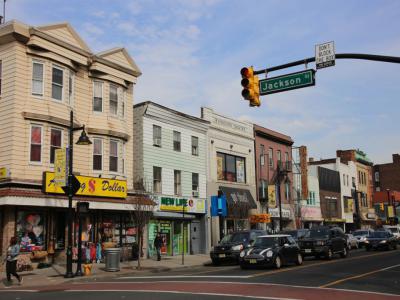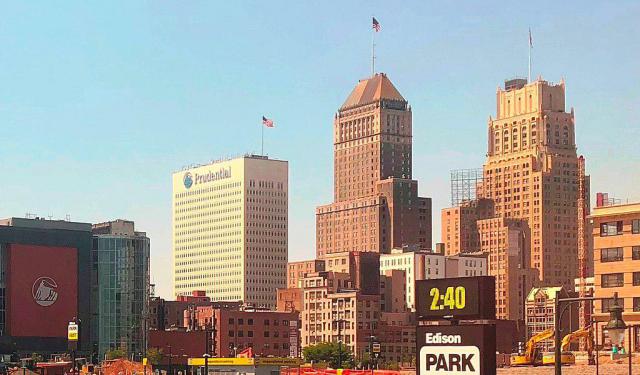
Ironbound and Ferry Street, Newark (must see)
The roots of today’s Ironbound neighborhood in Newark, trace back to the 19th-century transformation of the region into one of the nation’s first industrial corridors. This transition began with Alexander Hamilton, the first U.S. Secretary of the Treasury, who co-founded the Society for Establishing Useful Manufactures in 1792. The Society purchased 700 acres of land around New Jersey’s largest waterfall to establish the city of Paterson. Hamilton envisioned this city as a "New National Manufactory" that would drive the U.S. towards economic independence by fostering a shift from an agricultural to a manufacturing economy.
By the 1970s, the Portuguese community became the dominant ethnic group in Ironbound, following Portugal's "flower revolution" which ended the dictatorship of Antonio Salazar. The influx of Portuguese immigrants turned Ironbound into a vibrant center for the Portuguese diaspora in the U.S., earning it the nickname "Little Portugal." Throughout its history, Ironbound has been a mosaic of ethnic identities and cultural traditions, showcasing how diverse communities can coexist and enrich a multicultural society.
The mile-long stretch of Ferry Street, extending from Penn Station to St. Stephan’s Grace Community Church, forms the spine of Ironbound. Originally chartered in 1765 as Old Ferry Road, it was designed to connect ferries transporting goods and people from Manhattan and Jersey City to Newark’s marketplace. Over the years, Ferry Street has been a gateway for newcomers, providing a starting point for many immigrants to begin their new lives.
Today, Ferry Street is synonymous with food, particularly Iberian cuisine, which has attracted visitors and bolstered the local economy since the 1970s. More recently, immigrants from Latin American countries have diversified the culinary landscape, adding new flavors and cultural dimensions to the neighborhood. The rich tapestry of restaurants and eateries along Ferry Street not only showcases the diverse food offerings but also reflects the complex histories and memories of the Ironbound community. This vibrant food scene, coupled with the historical narratives of the buildings housing these establishments, tells the story of Ironbound's past and the resilient spirit of its people.
By the 1970s, the Portuguese community became the dominant ethnic group in Ironbound, following Portugal's "flower revolution" which ended the dictatorship of Antonio Salazar. The influx of Portuguese immigrants turned Ironbound into a vibrant center for the Portuguese diaspora in the U.S., earning it the nickname "Little Portugal." Throughout its history, Ironbound has been a mosaic of ethnic identities and cultural traditions, showcasing how diverse communities can coexist and enrich a multicultural society.
The mile-long stretch of Ferry Street, extending from Penn Station to St. Stephan’s Grace Community Church, forms the spine of Ironbound. Originally chartered in 1765 as Old Ferry Road, it was designed to connect ferries transporting goods and people from Manhattan and Jersey City to Newark’s marketplace. Over the years, Ferry Street has been a gateway for newcomers, providing a starting point for many immigrants to begin their new lives.
Today, Ferry Street is synonymous with food, particularly Iberian cuisine, which has attracted visitors and bolstered the local economy since the 1970s. More recently, immigrants from Latin American countries have diversified the culinary landscape, adding new flavors and cultural dimensions to the neighborhood. The rich tapestry of restaurants and eateries along Ferry Street not only showcases the diverse food offerings but also reflects the complex histories and memories of the Ironbound community. This vibrant food scene, coupled with the historical narratives of the buildings housing these establishments, tells the story of Ironbound's past and the resilient spirit of its people.
Want to visit this sight? Check out these Self-Guided Walking Tours in Newark. Alternatively, you can download the mobile app "GPSmyCity: Walks in 1K+ Cities" from Apple App Store or Google Play Store. The app turns your mobile device to a personal tour guide and it works offline, so no data plan is needed when traveling abroad.
Ironbound and Ferry Street on Map
Sight Name: Ironbound and Ferry Street
Sight Location: Newark, USA (See walking tours in Newark)
Sight Type: Attraction/Landmark
Guide(s) Containing This Sight:
Sight Location: Newark, USA (See walking tours in Newark)
Sight Type: Attraction/Landmark
Guide(s) Containing This Sight:
Walking Tours in Newark, New Jersey
Create Your Own Walk in Newark
Creating your own self-guided walk in Newark is easy and fun. Choose the city attractions that you want to see and a walk route map will be created just for you. You can even set your hotel as the start point of the walk.
Newark Introduction Walking Tour
Newark, the most populous city of New Jersey, is also one of the oldest cities in the United States, established in 1666. Settled by Puritans from New Haven Colony, Newark was initially a theocratic community, which diversified as new settlers introduced different ideas.
Named likely after Newark-on-Trent in England, the city's moniker reveals its colonial roots. Alternative theories... view more
Tour Duration: 2 Hour(s)
Travel Distance: 3.4 Km or 2.1 Miles
Named likely after Newark-on-Trent in England, the city's moniker reveals its colonial roots. Alternative theories... view more
Tour Duration: 2 Hour(s)
Travel Distance: 3.4 Km or 2.1 Miles
Newark's Historical Buildings Walking Tour
Founded in 1666, Newark has no shortage of historic locations: districts, buildings, parks, cemeteries, and other venues. Much of its old-time architecture are notable sites listed on the National Register of Historic Places.
One such is the Essex County Courthouse, a striking example of Renaissance architecture, built in 1904. This grand building, with its impressive marble columns, ornate... view more
Tour Duration: 2 Hour(s)
Travel Distance: 2.8 Km or 1.7 Miles
One such is the Essex County Courthouse, a striking example of Renaissance architecture, built in 1904. This grand building, with its impressive marble columns, ornate... view more
Tour Duration: 2 Hour(s)
Travel Distance: 2.8 Km or 1.7 Miles


